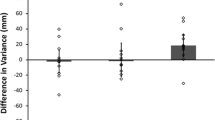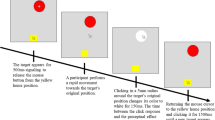Abstract
Increased involuntary arm movement deviation when observing an incongruent human arm movement has been interpreted as a strong indicator of motor contagion. Here, we examined the contribution of trajectory and end-point information on motor contagion by altering congruence between the stimulus and arm movement. Participants performed cyclical horizontal arm movements whilst simultaneously observing a stimulus representing human arm movement. The stimuli comprised congruent horizontal movements or vertical movements featuring incongruent trajectory and end-points. A novel, third, stimulus comprised curvilinear movements featuring congruent end-points, but an incongruent trajectory. In Experiment 1, our dependent variables indicated increased motor contagion when observing the vertical compared to horizontal movement stimulus. There was even greater motor contagion in the curvilinear stimulus condition indicating an additive effect of an incongruent trajectory comprising congruent end-points. In Experiment 2, this additive effect was also present when facing perpendicular to the display, and thus with end-points represented as a product of the movement rather than an external spatial reference. Together, these findings support the theory of event coding (Hommel et al., Behav Brain Sci 24:849–878, 2001), and the prediction that increased motor contagion takes place when observed and executed actions share common features (i.e., movement end-points).







Similar content being viewed by others
Notes
In this instance, congruency of trajectory was defined by movement differences in the vertical axis. The additional movement in the vertical axis for the curvilinear stimulus was clearly different from the horizontal stimulus, and thus was conceived as an incongruent trajectory.
References
Blakemore, S. J., & Frith, C. (2005). The role of motor contagion in the prediction of action. Neuropsychologia, 43, 260–267. doi:10.1016/j.neuropsychologia.2004.11.012.
Boria, S., Fabbri-Destro, M., Cattaneo, L., Sparaci, L., Sinigaglia, C., Santelli, E., Rizzolatti, G. (2009). Intention understanding in autism. PLoS ONE, 4, e5596. doi:10.1371/journal.pone.0005596.
Brass, M., Bekkering, H., Wohlschläger, A., & Prinz, W. (2000). Compatibility between observed and executed finger movements: Comparing symbolic, spatial and imitative cues. Brain and Cognition, 44, 124–143. doi:10.1006/brcg.2000.1225.
Cattaneo, L., Sandrini, M., & Schwarzbach, J. (2010). State-dependent TMS reveals a hierarchical representation of observed acts in the temporal, parietal, and premotor cortices. Cerebral Cortex, 20, 2252–2258. doi:10.1093/cercor/bhp291.
Chartrand, T. L., & Bargh, J. A. (1999). The chameleon effects: The perception-behavior link and social interaction. Journal of Personality and Social Psychology, 76, 893–910. doi:10.1037//0022-3514.76.6.893.
Csibra, G. (2007). Action mirroring and action understanding: An alternative account. In P. Haggard, Y. Rossetti, & M. Kawato (Eds.), Sensorimotor foundations of higher cognition, attention and performance XXII (pp. 435–459). Oxford: Oxford University Press.
di Pellegrino, G., Fadiga, L., Fogassi, L., Gallese, V., & Rizzolatti, G. (1992). Understanding motor events: A neurophysiological study. Experimental Brain Research, 91, 176–180. http://link.springer.com/journal/221/91/1/page/1.
Dijkerman, H. C., & Smit, M. C. (2007). Interference of grasping observation during prehension, a behavioural study. Experimental Brain Research, 176, 387–396. doi:10.1007/s00221-006-0627-z.
Gowen, E., Stanley, J., & Miall, R. C. (2008). Movement interference in autism-spectrum disorder. Neuropsychologia, 46, 1060–1068. doi:10.1016/j.neuropsychologia.2007.11.004.
Grafton, S. T., & Hamilton, A. F. (2007). Evidence of a distributed hierarchy of action representation in the brain. Human Movement Science, 26, 590–616. doi:10.1016/j.humov.2007.05.009.
Hamilton, A. F. D., & Grafton, S. (2006). Goal representation in human anterior intraparietal sulcus. The Journal of Neuroscience, 26, 1133–1137. doi:10.1523/JNEUROSCI.4551-05.2006.
Hardwick, R. M., & Edwards, M. G. (2011). Observed reach trajectory influences executed reach kinematics in prehension. Quarterly Journal of Experimental Psychology, 64, 1082–1093. doi:10.1080/17470218.2010.538068.
Hardwick, R. M., & Edwards, M. G. (2012). Motor interference and facilitation arising from observed movement kinematics. Quarterly Journal of Experimental Psychology, 65, 840–847. doi:10.1080/17470218.2012.672995.
Hayes, S. J., Ashford, D., & Bennett, S. J. (2008). Goal-directed imitation: The means to an end. Acta Psychologica, 131, 202–208. doi:10.1016/j.actpsy.2009.05.002.
Heyes, C., Bird, G., Johnson, H., & Haggard, P. (2005). Experience modulates automatic imitation. Cognitive Brain Research, 22, 233–240. doi:10.1016/j.cogbrainres2004.09.009.
Hommel, B., Müsseler, J., Aschersleben, G., & Prinz, W. (2001). The Theory of Event Coding (TEC): A framework for perception and action planning. Behavioral and Brain Sciences, 24, 849–878. doi:10.1017/S0140525X01000103.
Iacoboni, M., Woods, R. P., Brass, M., Bekkering, H., Mazziotta, J. C., & Rizzolatti, G. (1999). Cortical mechanisms of human imitation. Science, 286, 2526–2568. doi:10.1126/science.286.5449.2526.
Jansson, E., Wilson, A. D., Williams, J. H. G., & Mon-Williams, M. (2007). Methodological problems undermine tests of ideo-motor conjecture. Experimental Brain Research, 182, 549–558. doi:10.1007/s00221-007-1013-1.
Khan, M. A., Franks, I. M., & Goodman, D. (1998). The effect of practice on the control of rapid aiming movement: Evidence for an interdependency between programming and feedback processing. The Quarterly Journal of Experimental Psychology, 51A, 425–444. doi:10.1080/713755756.
Kilner, J. M., Hamilton, A. F., & Blakemore, S. J. (2007). Interference effect of observed human movement on action is due to velocity profile of biological motion. Social Neuroscience, 2, 158–166. doi:10.1080/17470910701428190.
Kilner, J. M., Paulignan, Y., & Blakemore, S. J. (2003). An interference effect of observed biological movement on action. Current Biology, 13, 522–525. doi:10.1080/17470910701428190.
Mattar, A. A. G., & Gribble, P. L. (2005). Motor learning by observing. Neuron, 46, 153–160. doi:10.1016/j.neuron.2005.02.009.
Ocampo, B., Painter, D. R., & Kritikos, A. (2012). Event coding and motor priming: how attentional modulation may influence binding across action properties. Experimental Brain Research, 219, 139–150. doi:10.1007/s00221-012-3073-0.
Press, C. (2011). Action observation and robotic agents: Learning and anthropomorphism. Neuroscience and Biobehavioural Reviews, 35, 1410–1418. doi:10.1016/j.neubiorev.2011.03.004.
Press, C., Bird, G., Walsh, E., & Heyes, C. (2008). Automatic imitation of intransitive actions. Brain and Cognition, 67, 44–50. doi:10.1016/j.bandc.2007.11.001.
Prinz, W. (1997). Perception and action planning. European Journal of Cognitive Psychology, 9, 129–154. doi:10.1080/713752551.
Richardson, M. J., Campbell, W. L., & Schmidt, R. C. (2009). Movement interference during action observation as emergent coordination. Neuroscience Letters, 449, 117–122. doi:10.1016/j.neulet.2008.10.092.
Rizzolatti, G., Fogassi, L., & Gallese, V. (2001). Neurophysiological mechanisms underlying the understanding and imitation of action. Nature Reviews Neuroscience, 2, 661–670. doi:10.1038/35090060.
Stanley, J., Gowen, E., & Miall, R. C. (2007). Effects of agency on movement interference during observation of a moving dot stimulus. Journal of Experimental Psychology: Human Perception and Performance, 33, 915–926. doi:10.1037/0096-1523.33.4.915.
Wohlschläger, A., Gattis, M., & Bekkering, H. (2003). Action generation and action perception in imitation: An instance of the ideomotor principle. Philosophical Transactions of the Royal Society of London B, 358, 501–515. doi:10.1098/rstb.2002.1257.
Author information
Authors and Affiliations
Corresponding author
Rights and permissions
About this article
Cite this article
Roberts, J.W., Hayes, S.J., Uji, M. et al. Motor contagion: the contribution of trajectory and end-points. Psychological Research 79, 621–629 (2015). https://doi.org/10.1007/s00426-014-0589-x
Received:
Accepted:
Published:
Issue Date:
DOI: https://doi.org/10.1007/s00426-014-0589-x




